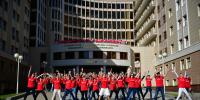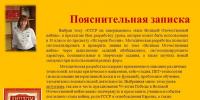State University of Management. Training system from Alexander Pasko - second six months Correct BB Pasko
The forum administration does not approve of the use of potent drugs without proper medical supervision. All information and advice from users is provided as additional knowledge only. We do not promote or force people to use doping.
Position, rank, degree
Associate Professor of the Department of World Economy, Candidate of Economic Sciences, Associate Professor
Education
- State University Management, Institute of National and World Economy, specialty “World Economy” – 080102, 2008.
- 2011 Candidate of Economic Sciences, specialty 08.00.14 “World Economy”
- 2015 title of “Associate Professor at the Department of World Economy”
Disciplines taught
Conditions and pricing in the world market, World economy and IEO, Economy of foreign countries, Competitiveness in the world economy
Professional experience
- Secretary of the selection committee for admission of applicants to the Federal State Budgetary Educational Institution of Higher Professional Education "State University of Management" in 2013-2014;
- deputy executive secretary of the selection committee for admission of applicants to the Federal State Budgetary Educational Institution of Higher Professional Education "State University of Management" in 2014-2015.
- Scientific secretary of the dissertation council for the defense of dissertations for competition scientific degree Doctor of Science, Candidate of Science D 212.049.11 on the basis of the Federal State Budgetary Educational Institution of Higher Professional Education "State University of Management" (economic sciences)
Scientific interests
International trade, development trends in the passenger car industry, specifics of pricing on world commodity markets
Training
- “New in the Procedure for Admission to Study Programs higher education and organizations admissions campaign for the 2015-2016 academic year.
- Peculiarities of admission and organization of training for foreign citizens" NGO "Inter-industry Institute for Advanced Studies and professional retraining personnel", Moscow, 2014.
Total work experience, work experience in the specialty: 9 years old, 9 years old
Publications
|
Educational and methodological works |
|||||
|
Study program in the discipline “Conjuncture and pricing in the world market” for bachelors in the field of study “Economics” – 080100, training profile “World Economy” |
M.: Sputnik Plus, 2014. – 20 p. |
||||
|
Curriculum in the discipline “Economics of Foreign Countries” for students of the profile 38.03.01-40 “World Economy” |
M.: 11th Format, 2014. – 24 p. |
V.V. Aturin, K.G. Grigoryan |
|||
|
Conditions and pricing on the world market (textbook) |
M.: OMEPI IE RAS, 2014. – 188 p. |
||||
|
Curriculum for the discipline “World Economy and International economic relations» for full-time and part-time bachelors in the field of study “Economics” – 03/38/01, training profile 04 – “World Economy” |
M.: Sputnik Plus, 2015. – 18 p. |
||||
|
Scientific works |
|||||
|
Russian-Swedish trade and economic relations (report abstracts) |
Materials of the 17th All-Russian student seminar “Problems of Management”. – M.: State University of Education, 2009. Issue 2. – P.132-133. |
||||
|
The impact of the global financial crisis on the development of the global automobile market (report abstracts) |
Materials of the 14th All-Russian scientific-practical conference “Actual problems management – 2009” – M.: State University of Management, 2009. Issue 5. – P.69-73. |
||||
|
Global car market: current state and development trends (article) |
Bulletin of the University (State University of Management). 2009. No. 23. – P.45-48. |
||||
|
Modern strategies for the development of transnational corporations in the global automotive industry (using the example of Sweden) (article) |
University Bulletin. 2010. No. 16. – P.125-129. |
||||
|
Modern strategies of transnational corporations in the global passenger car market (using the example of the Swedish company Volvo). Monograph. |
M.: Sputnik Plus Company, 2011. – 140 p. |
||||
|
The strategy of the Swedish corporation Volvo and its prospects in the Russian passenger car market (article) |
Bulletin of the University (State University of Management). 2011. No. 5. – P.112-116. |
||||
|
Formation of localization strategies in foreign automobile markets (article) |
Sat. scientific works"A New Look. International Scientific Bulletin." - Novosibirsk, 2013. – P.65-80. |
||||
|
Prerequisites for transforming the strategies of automotive transnational corporations in modern conditions (article) |
Bulletin of the University (State University of Management). 2014. No. 9. – P.43-47. (list of Higher Attestation Commission, No. 531) |
||||
|
The mechanism for developing sales strategies of leading automobile corporations in modern stage(article) |
Bulletin of the University (State University of Management). 2014. No. 10. – P.51-55. (list of Higher Attestation Commission, No. 531) |
||||
|
Features of the influence of globalization on the development of the global automotive industry (article) |
Bulletin of the University (State University of Management). 2014. No. 11. – P.48-52. (list of Higher Attestation Commission, No. 531) |
||||
|
Management of foreign trade policy in order to develop the Russian car market (article) |
Bulletin of the University (State University of Management). 2014. No. 12. – P.48-53. (list of Higher Attestation Commission, No. 531) |
||||
|
Directions for the development of the Russian automotive industry in the context of membership in the World Trade Organization (WTO) (article) |
Bulletin of the University (State University of Management). 2014. No. 13. - With. 50-55. (list of Higher Attestation Commission, No. 531) |
||||
|
Parameters and factors of development of the global automotive industry at the beginning of the 21st century (article) |
Modern trends in economics and management: a new look. 2014. No. 27. pp. 27-34. |
||||
|
Corporate strategies of automobile corporations in the context of globalization of the world automotive industry |
Problems modern economy(Novosibirsk). 2014. No. 20. P.38-50. |
||||
|
Competitiveness of the Russian automotive industry against the background of key trends in the development of the global automotive industry |
A New Look. International Scientific Bulletin. 2014. No. 4. P.201-218. |
||||
|
Factors of international competitiveness of automobile manufacturers (using the example of the USA) |
Current Aspects modern science. Collection of materials Vth international scientific and practical conference (Lipetsk, August 22, 2014). / Rep. ed. EAT. Mosolova. – Lipetsk: “RaDushi”, 2014. – 132 p. (P.54-64). |
||||
|
Assessment of foreign economic competitiveness of Russian automotive industry enterprises |
[Electronic resource]. – Electronic journal"Economy and Society". 2014. No. 2(11). – Access mode: http://www.iupr.ru/domains_data/files/zurnal_11_iun/Pasko%20AV%20(Osnovnoy%20razdel).pdf |
||||
|
The role of international transport corridors in the development of Russia’s foreign economic potential |
A New Look. International Scientific Bulletin. 2014. No. 6. P.56-62 |
||||
|
Import of automotive products to Russia under economic sanctions |
A New Look. International Scientific Bulletin. 2015. No. 3. P.24-30. |
||||
|
Changes in the dynamics of sales and imports of passenger cars on the Russian market under the influence of instability in the external environment. |
"Ukrainian school" Day A Day B Mon/Tue-A, Wed/Thu-B, Fri/Sat-A, Mon/Tue-B, Wed/Thu-A, Fri/Sat-B… Phase 2. “Variable rate” Day A Day B Day B Phase 3: Impact Split Day A 2x5 barbell clean Day B Day G When training according to the “Ukrainian School” there are no dietary restrictions!!! The scheme itself will force you to eat everything in a row and in large quantities, otherwise it will quickly break you! It’s not for nothing that it’s called the “Ukrainian School.” Food on it in the form of lard, dumplings, potatoes, mountains of pies, a pot of borscht a day, a jar of sour cream, etc. is the norm! In all exercises that are performed with weights, a heavy failure approach is ONLY THE LAST!!! All previous approaches are used as lead-ups and the weight in them is increased evenly and smoothly, gradually leading up to the weight for the last approach! This applies to all phases of the “Ukrainian School”! As you already noticed, there are a lot of strange exercises in it. For example, “Shwung” or “Cleaning the barbell”... This is from weightlifting! You can dig up the technique for these exercises yourself, or you can find it soon on our website in the “Exercises” section. "Three Tens" Do not rearrange exercises! In each exercise, the first 8-9 approaches are lead-in (warm-up), i.e. in the first approach, the minimum weight is taken for 10 repetitions and, in each subsequent approach, it is gradually and evenly increased to the working weight, which should fall on the 9-10th approach! Having completed 9 workouts (three weeks, three times a week, every other day), you need to rest for 10 days and proceed to the next scheme, which will help you recover from the latest shocks in the strength and tens. This is the final touch in this cycle. Recovery Day A Chest+Biceps+Abs Day B Legs+Shoulders Day B Back+Triceps+Abs Train three times a week according to the scheme: Mon/Tue-A, Wed/Thu-B, Fri/Sat-W.. and so on. This phase is designed for 12-15 workouts. After it you should rest for 10-14 days. Sometimes 21 days of rest won't hurt! | ||||



